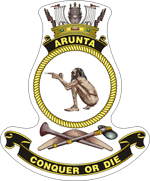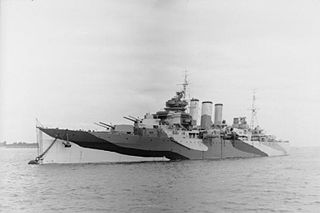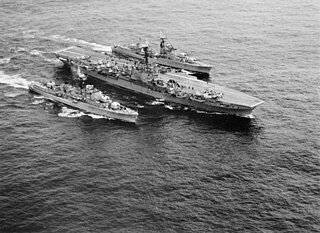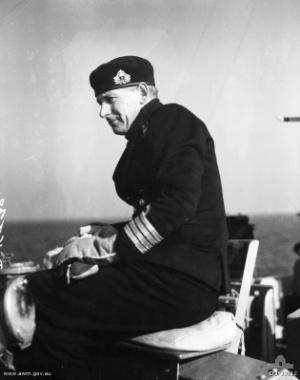
HMAS Bataan (D9/I91/D191) was a Tribal-class destroyer of the Royal Australian Navy (RAN). Laid down in 1942 and commissioned in 1945, the destroyer was originally to be named Chingilli or Kurnai but was renamed prior to launch in honour of the US stand during the Battle of Bataan.

HMAS Napier (G97/D13) was an N-class destroyer serving in the Royal Australian Navy (RAN) during World War II. Built during 1939 and 1940, the destroyer was commissioned into the RAN, although she was ordered and owned by the British government. During 1941, Napier operated in the Mediterranean, before being transferred to the British Eastern Fleet at the start of 1942, then to south Atlantic operations in early 1944. In 1945, Napier was assigned to the British Pacific Fleet, and spent the rest of World War II in the fight against Japan. After the war's end, the destroyer was decommissioned and returned to the British. She was sold off in 1955, and broken up in 1956.

HMAS Nizam (G38/D15) was an N-class destroyer of the Royal Australian Navy (RAN). The destroyer, named after Osman Ali Khan, the last Nizam of Hyderabad, was commissioned into the RAN in 1940, although the ship remained the property of the Royal Navy for her entire career.

HMAS Quiberon (G81/D20/D281/F03) was a Q-class destroyer of the Royal Australian Navy (RAN). Although built for the Royal Navy and remaining British property until 1950, Quiberon was one of two Q-class destroyers commissioned into the RAN during World War II. She was passed into full RAN ownership in 1950, and converted into an anti-submarine frigate.

HMS Jamaica, a Fiji-class cruiser of the Royal Navy, was named after the island of Jamaica, which was a British Crown Colony when she was built in the late 1930s. The light cruiser spent almost her entire wartime career on Arctic convoy duties, except for a deployment south for the landings in North Africa in November 1942. She participated in the Battle of the Barents Sea in 1942 and the Battle of North Cape in 1943. Jamaica escorted several aircraft carriers in 1944 as they flew off airstrikes that attacked the German battleship Tirpitz in northern Norway. Late in the year she had an extensive refit to prepare her for service with the British Pacific Fleet, but the war ended before she reached the Pacific.

HNLMS Tromp was the lead ship of the Tromp-class destroyer leaders built for the Royal Netherlands Navy. Built just prior to World War II, the ship served mainly in the Pacific and Indian Oceans against the Japanese, being based out of Sydney, Fremantle and Trincomalee where she served alongside British, Australian and US warships. After the war, she returned to the Netherlands and after 1949 Tromp was used as a training and accommodation ship, before being decommissioned in 1955, and scrapped in 1969.

HMAS Sydney, named after the Australian city of Sydney, was one of three modified Leander-class light cruisers operated by the Royal Australian Navy (RAN). Ordered for the Royal Navy as HMS Phaeton, the cruiser was purchased by the Australian government and renamed prior to her 1934 launch.

HMAS Hobart was a modified Leander-class light cruiser which served in the Royal Australian Navy (RAN) during World War II. Originally constructed for the Royal Navy as HMS Apollo, the ship entered service in 1936, and was sold to Australia two years later. During the war, Hobart was involved in the evacuation of British Somaliland in 1940, fought at the Battle of the Coral Sea and supported the amphibious landings at Guadalcanal and Tulagi in 1942. She was torpedoed by a Japanese submarine in 1943, then returned to service in 1945 and supported the landings at Tarakan, Wewak, Brunei, and Balikpapan. Hobart was placed in reserve in 1947, but plans to modernise her and return her to service as an aircraft carrier escort, training ship, or guided missile ship were not followed through. The cruiser was sold for scrapping in 1962.

HMAS Australia (I84/D84/C01) was a County-class heavy cruiser of the Royal Australian Navy (RAN). One of two Kent-subclass ships ordered for the RAN in 1924, Australia was laid down in Scotland in 1925, and entered service in 1928. Apart from an exchange deployment to the Mediterranean from 1934 to 1936, during which she became involved in the planned British response to the Abyssinia Crisis, Australia operated in local and South-West Pacific waters until World War II began.

HMAS Perth was one of three modified Leander-class light cruisers used by the Royal Australian Navy (RAN) during the early part of World War II. She was built for the Royal Navy (RN) in the mid-1930s and was commissioned as HMS Amphion in 1936. The ship spent the next several years as flagship of the Commander-in-Chief, Africa before she was transferred to the RAN in 1939 and renamed as HMAS Perth.

HMAS Anzac (D59) was a Battle-class destroyer of the Royal Australian Navy (RAN). Named after the Australian and New Zealand Army Corps, the destroyer was commissioned in 1951. The ship served on two tours of duty during the Korean War, and attempts to distinguish herself from British ships led to the practice of red kangaroo symbols on Australian warships. During 1956, Anzac served during the Malayan Emergency. In 1960, a malfunction in the destroyer's gun direction equipment caused Anzac to fire directly on sister ship HMAS Tobruk during a gunnery exercise, with Tobruk left unrepairable. In 1961, the destroyer was reclassified as a training vessel. Anzac remained in service until 1974, and was sold for breaking a year later.

HMAS Arunta (I30/D5/D130) was a Tribal-class destroyer of the Royal Australian Navy (RAN). Named for the Arrernte Aboriginal peoples, the destroyer was laid down in 1939 and commissioned into the RAN in 1942.

HMS Shropshire was a Royal Navy (RN) heavy cruiser of the London sub-class of County-class cruisers. She is the only warship to have been named after Shropshire, England. Completed in 1929, Shropshire served with the RN until 1942, when she was transferred to the Royal Australian Navy (RAN) following the loss of sister ship HMAS Canberra. Commissioned as HMAS Shropshire, the ship remained in RAN service until 1949, and was sold for scrap in 1954.

HMAS Canberra (I33/D33), named after the Australian capital city of Canberra, was a Royal Australian Navy (RAN) heavy cruiser of the Kent sub-class of County-class cruisers. Constructed in Scotland during the mid-1920s, the ship was commissioned in 1928, and spent the first part of her career primarily operating in Australian waters, with some deployments to the China Station.

HMAS Norman (G49/D16) was an N-class destroyer operated by the Royal Australian Navy (RAN) during World War II. Entering service in 1941, the ship was on loan from the Royal Navy.

HMAS Vampire was the third of three Australian-built Daring-class destroyers serving in the Royal Australian Navy (RAN). One of the first all-welded ships built in Australia, she was constructed at Cockatoo Island Dockyard between 1952 and 1959, and was commissioned into the RAN a day after completion.

HMAS Voyager was a Daring-class destroyer of the Royal Australian Navy (RAN), that was lost in a collision in 1964.

HMAS Vendetta was one of three Daring-class destroyers built for and operated by the Royal Australian Navy (RAN). The destroyer was built by Williamstown Naval Dockyard and entered service in 1958. During her early career, Vendetta was deployed to the Far East Strategic Reserve on multiple occasions. In 1965 and 1966, the destroyer undertook deterrence patrols during the Indonesia-Malaysia Confrontation. Along with several runs escorting the troop transport HMAS Sydney to South Vietnam, from late 1969 to early 1970 Vendetta was assigned to combat operations and became the only Australian-built warship to serve in a shore bombardment role during the Vietnam War.

HMAS Vendetta (D69/I69) was a V-class destroyer that served in the Royal Navy and the Royal Australian Navy (RAN). One of 25 V class ships ordered for the Royal Navy during World War I, Vendetta entered service in 1917.

Rear Admiral Otto Humphrey Becher, & Bar was a senior officer in the Royal Australian Navy (RAN). Born in Harvey, Western Australia, Becher entered the Royal Australian Naval College in 1922. After graduating in 1926, he was posted to a series of staff and training positions prior to specialising in gunnery.




















